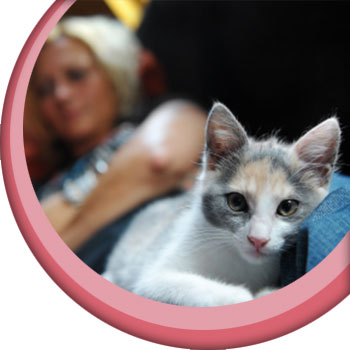Respiratory Disease in Cats
Respiratory disease can be broadly divided into two categories: disease affecting the upper respiratory tract i.e. the nose, throat and trachea (windpipe), and disease affecting the lower respiratory tract i.e. the lower airways and lungs.
Infectious upper respiratory tract disease in cats is very common and is often referred to as “cat flu”. This is a collective term for several viruses and bacteria that infect the upper respiratory tract and spread easily amongst animals. Routine vaccinations cover for some of these infections. Cat flu is more common in cats that have not been vaccinated, been stray or acquired the disease as kittens before starting vaccinations. Two of the viruses involved remain latent in the body once infection has occurred. This means that the body will never get rid of the infection completely and it may flare up periodically, much like cold sores in people. This is more likely to occur at times of stress or other illness. It also means these cats may be a source of infection for other cats.

Other less common causes of upper respiratory tract disease include foreign bodies e.g. blades of grass lodged in the nose/throat, and tumours.
Symptoms
• Sneezing and nasal discharge.
• Faster or more noticeable breathing, or breathing with their mouth open.
• Snuffly or noisy breathing.
• Discharge from the eyes or sore and red eyes.
• Reduced appetite or being off colour – cats will often have a high temperature with an upper respiratory tract infection which may make them feel generally unwell.
• Sometimes coughing or gagging/retching.
Diagnosis
To aid in the diagnosis and treatment of upper respiratory tract infections your vet may take swabs to send away to culture for bacteria or isolate viruses. If they suspect a foreign body or tumour they may need to take x-rays or use an endoscope to look at the airways. An endoscope is a flexible probe with a camera that is passed into the airway while the animal is under general anaesthesia (fully asleep).
Preventing flare-ups
• The main bugs causing upper respiratory tract infections in cats are viruses and no specific treatment is available. However, there are also bacterial components and viral infection makes the body more susceptible to secondary bacterial infection, therefore antibiotics may be prescribed if bacteria are found during culture and sensitivity testing.
• Anti-inflammatories may be used if necessary.
• Reduced sense of smell may put cats off eating (like when you have a cold); tempting them with strong smelling food or gently warming food may help.
• Steam can help reduce mucus building up in the nose, again like when you have a cold. If your cat is happy to stay in the bathroom while the shower is on this may help them feel more comfortable.
For other conditions your vet will be able to advise you on the best treatment options.
Lower respiratory tract disease
There are several possible causes of lower respiratory tract disease in cats. These include:
• Infection – bronchitis/pneumonia.
• Tumours – this can be tumours of the lungs or spread from tumours elsewhere in the body.
• Trauma – this most commonly occurs due to road traffic accidents and can cause air to enter the chest or result in damage such as a ruptured diaphragm (the diaphragm divides the chest from the abdomen).
• Heart problems.
Signs of lower respiratory tract disease include:
• Coughing.
• Wheezing or noisy breathing.
• Faster or more forceful breathing, or breathing with their mouth open.
It can often be difficult to identify the cause of lower respiratory tract disease without further investigation. Therefore your vet may wish to take x-rays of your cat’s chest. Click here to find out more about Diagnostic Imaging. They may also use endoscopy to look at the airways – this involves passing a camera down the trachea (windpipe). The endoscope can also be used to aid taking samples from the lower airways to send away for culture and sensitivity to check for bacterial infection. If a heart problem is suspected a heart scan may be suggested. Your vet will be able to discuss appropriate treatment with you once they have made a diagnosis.
If you think your cat is showing any of the signs mentioned above it is important to take them to your vet as soon as possible as some of the conditions may be life threatening if left untreated.
Disclaimer: This website has been designed to offer information surrounding the use of antibiotics and infection control for pet owners. It does not replace advice from your veterinary surgeon. If you believe your pet is unwell or you have any questions relating to their treatment, please always contact your veterinary surgeon for advice.

